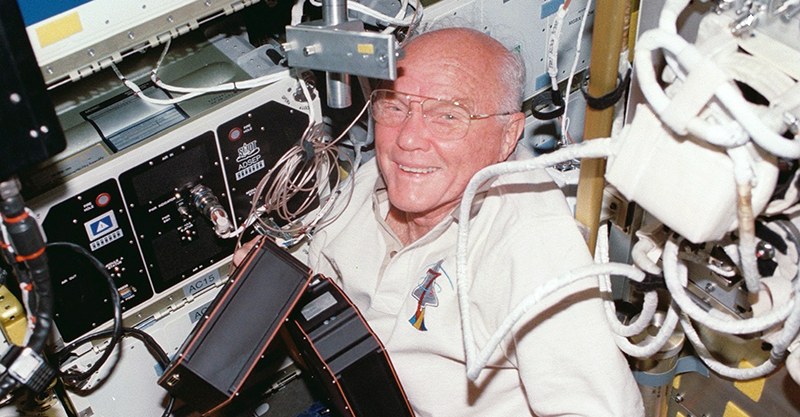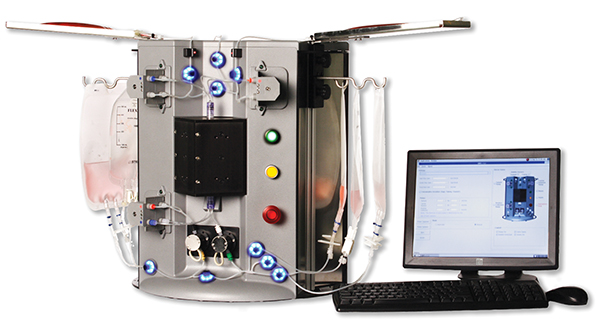
Magnetic Separator Enhances Treatment Possibilities
Originating Technology/NASA Contribution
Since the earliest missions in space, NASA specialists have performed experiments in low gravity. Protein crystal growth, cell and tissue cultures, and separation technologies such as electrophoresis and magnetophoresis have been studied on Apollo 14, Apollo 16, STS-107, and many other missions.
Electrophoresis and magnetophoresis, respectively, are processes that separate substances based on the electrical charge and magnetic field of a molecule or particle. Electrophoresis has been studied on over a dozen space shuttle flights, leading to developments in electrokinetics, which analyzes the effects of electric fields on mass transport (atoms, molecules, and particles) in fluids. Further studies in microgravity will continue to improve these techniques, which researchers use to extract cells for various medical treatments and research.
Partnership
As part of the NASA Shuttle Student Involvement Program, John Vellinger designed an experiment to study the effect of low gravity on chicken embryos. After his freshman year at Purdue University in 1985, Vellinger partnered with KFC Corporation staff engineer, Mark Deuser, who helped Vellinger design the “Chix in Space” experiment for two space shuttle missions. Their work together laid the foundation for creating Space Hardware Optimization Technology Inc. (SHOT) in 1988, after acquiring a NASA contract for space flight hardware development.
Since 1988, four NASA centers—Marshall Space Flight Center, Glenn Research Center, Johnson Space Center, and Ames Research Center—have issued over 25 Small Business Innovation Research (SBIR) contracts to the Greenville, Indiana-based company, which has since changed its name to Techshot Inc. For its first 13 years, Techshot served exclusively as a NASA payload company, specializing in space hardware and later, separation technologies. Techshot engineers designed and integrated hardware for three suborbital rocket flights, seven space shuttle missions, and several payloads for the International Space Station.
Working with the Consortium for Materials Development in Space at the University of Alabama in Huntsville, Techshot won a contract to develop separation technologies for space application. Separation technologies involve the analysis and purification of proteins or “markers” which reveal information about diseases and the body. With the addition of Paul Todd as chief scientist in 2000, Techshot realized the value of terrestrial applications of separation technology, and explored experimental possibilities with Marshall and Johnson.
Product Outcome
Accustomed to working with the exacting requirements for space payloads, Techshot took a logical step in commercializing separation technology for the equally strict medical field, beginning with an organic separator developed for the Organic Separation Experiment that first flew on STS-57. Next, the company developed advanced separators based on the Advanced Space Experiment Processor (ADSEP), operated in low gravity without using a centrifugal field. These technologies provide biphasic, electrophoretic, and magnetic separation capabilities.
During early development of these separators, Techshot found the number of cells collected was insufficient for the needs of the experiment, for example, in stem cell transplants. To remedy this, Techshot purchased the license for a magnetic separation technology from the Cleveland Clinic Foundation, already shown to produce enough cells for a stem cell transplant. The resulting system—Magsort—is a multistage electromagnetic separator for purifying cells and magnetic particles for a variety of research and medical uses, including stem cell research and cancer treatment, in a much more refined manner than previously possible.
A laboratory apparatus for separating particles (especially biological cells), Magsort separates cells based on their magnetic susceptibility and magnetophoretic mobility. Magsort refines a sample population of particles by categorizing multiple portions of the sample and separating substances into individual parts, instead of as entire sets. As Todd explains, “If you have a mixture of cells—A, B, C, and D—Magsort will separate and collect A and B and C and D and put them separately in the hands of a research investigator . . . . Other existing methods would sort out only B, for example.”
The cells of interest might only be present in low numbers, so refined separation techniques are necessary for effective research. In its magnetophoretic process, the Magsort creates magnetic particles that are smaller than the cell but react only to one certain cell type. The hematological stem cells, for example, have molecules on their surface (clusters of differentiation 34) that can react with an antibody and then attach to a magnetic particle. If the mixture is then placed in a magnetic field, only the stem cells will be drawn to the magnet.
Magsort includes an electronic unit coupled to a built-in computer and a processing unit that includes horizontal upper and lower plates, a plate rotation system, a graded series of capture magnets above the upper plate, and a wheel for sequencing the small permanent capture magnets. The bolted plates rotate, and an interface between them acts as a seal for separating fluids. Up to 15 upper cuvette stations allow for fraction collection; a stepping motor drives the rotation system, causing the upper plate to rotate for fractional sample collection. User interface software displays the status of the various components on a small organic light-emitting diode (LED) monitor: the translating electromagnet, capture magnet, and the rotation of the upper plate.
Techshot is currently developing other separation products for the medical field. A Techshot spinoff company, IKOTech LLC, is commercializing a version of the Magsort called the Quadruple Magnetic Sorter; it is used primarily for stem cell processes and cancer research and treatment, including the detection of rare cancer cells and the removal of undesired cells from bone marrow transplants. Another model is being developed for type 1 diabetes pancreas islet transplants. Todd explains, “Right now, it takes two or three donor organs to treat one person. Our process greatly increases the yield.” With enough healthy (transplanted) beta cells of their own, patients’ symptoms could vanish.
Techshot credits the success of their separation technologies with their years of experience with NASA, and consider the company itself a spinoff. Rich Boling, vice president of corporate advancement, claims that Techshot’s years of experience in payloads made their commercial separators possible, as their capabilities as a company were “refined in the crucible of human space flight.”

Techshot and IKOTech licensed and commercialized this Quadruple Magnetic Sorter, which uses magnetophoresis for cancer research and stem cell processes.

Payload Specialist John Glenn worked with Techshot’s ADSEP hardware aboard Space Shuttle Discovery on STS-95.













